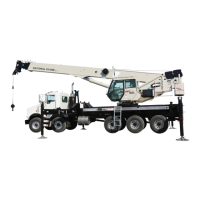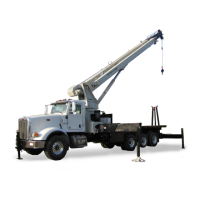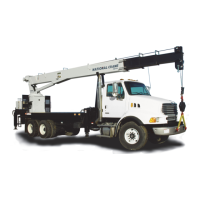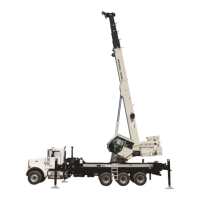HYDRAULIC SYSTEM NBT40 SERVICE MANUAL
2-6 Published 8-01-2017 Control # 287-11
• To remove entrapped air from telescope cylinders, lower
the boom to below horizontal and fully telescope the
boom in and out several times.
• If the air is still trapped, lower the boom to below
horizontal, extend the telescope cylinders as far as
practical, and allow the boom to remain in this position
overnight. This should allow trapped air to find its way to
the holding valve so that telescoping the boom IN the
next morning should force the air back to the reservoir.
Ensure the boom is first telescoped IN (not OUT) in the
morning. Telescoping OUT may cause air to be forced
back into a cylinder.
• Trapped air can be removed from cylinders having wet
rods by cycling. On certain cylinders, a plugged port is
provided on the rod end to bleed off trapped air.
• In the event that trapped air persists, bleed off the air by
loosening various clamp and screw type fittings.
• If the above procedures fail to eliminate trapped air,
contact your authorized National Crane Distributor.
SYSTEM DESCRIPTION
The hydraulic system is pressure compensated with a closed
center. The hydraulic system of the NBT40 series cranes
consist of the following:
• Axial Piston Pump
• Three Section Main Control Valve (Standard)
• Optional Four Section Main Control Valve for Auxiliary
Hoist
• RCL Lockout Manifold
• Swing Control Valve
• Outrigger Control Manifolds
• Hydraulic Tank with Filter
• Hydraulic Remote Controllers (HRC)
Axial Piston Pump
The axial piston pump is pressure compensated and
supplies a 286 l (75.5 gpm) flow of up to 27579 kPa (4000
psi) at a pump shaft speed of 1900 rpm. A shaft speed of
1000 rpm delivers 35 gpm which is enough to run any single
function at full speed. Higher speeds are required when
running two or more functions at the same time. The pump
has a load sense standby pressure of 2413-2757 kPa (350 -
400 psi).
Main Control Valve
The main control valve is located in the turret and has three
sections. The main control valve and controls the hoist, lift,
and telescope.
- Section one controls the boom up and down and
contains a lift relief valve that protects the lift down
circuit, lift up is protected by the system relief valve.
- Section two controls the hoist and uses the work
port relief valve to protect the hoist circuit.
- Section three controls the telescope out and
telescope in and contains the extend and retract
relief valves.
- Optional fourth section controls the auxiliary hoist
and uses the work port relief to protect the hoist
circuit.
The main and the load sense relief valves are located in the
main relief valve.
Swing Control Valve
The swing control valve is located in the turret and controls
the swing motor. The valve limits the maximum flow to
72 l (16 gpm) in both directions and has internal relief valves
that are set to 21373 kPa (3100 psi). The valve has an open
center that goes back to tank when the valve is in the neutral
position.
RCL Dump Manifold
The RCL dump manifold is located in the turret and disables
crane functions when the RCL senses an impending tipping
condition. The manifold dumps the HRC pressures for the
crane functions that make the condition worse (hoist up,
boom down, telescope out). The functions are returned when
the impending tipping condition is eliminated.
Outrigger Control Manifolds
The outrigger manifolds control the outrigger functions. The
outrigger circuit is set to operate at 20684 kPa (3000 psi)
DANGER
Locate the machine on a firm supporting surface and
position the boom over the front on outriggers when
extending the boom at low angles.
DANGER
Extreme care must be used when removing any plugs or
restrictions from a hydraulic system suspected to have
entrapped air that may be pressurized.
DANGER
Do not attempt to loosen fittings in pressurized lines or
while the hydraulic pumps are in operation.
Reference Only
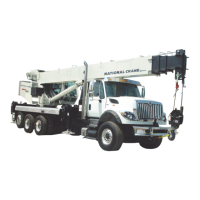
